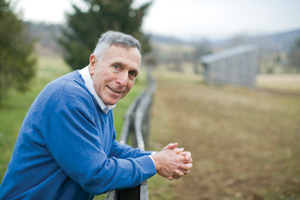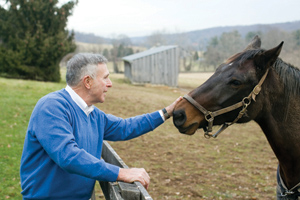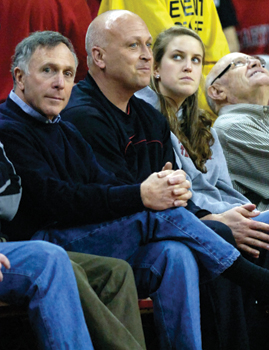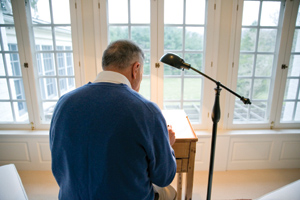As he returned to the dinner table, a slice of homemade apple pie in hand, Ron Shapiro fielded the sort of question that marks the simple rhythm of a couple’s life.
“Did you lock the chickens up?” his wife, Cathi, asked him.
 |
Ron Shapiro sometimes describes himself as "accidental sports agent."
Photo: NICK GRINER PHOTOGRAPHY
|
Shapiro tilted his head.
He and Cathi have owned and occupied Mistfield Farm, a 150-acre spread about 25 miles north of Baltimore, for 23 years now. So he’s used to their chats about chickens and horses and the occasional homegrown crop.
But, in the context of his story — “accidental sports agent,” as he sometimes describes himself; Baltimore politico; trusted counsel to influencers across sports — it seems an unlikely scene.
The son of an immigrant who sold encyclopedias door-to-door before building a successful plumbing supply business, Shapiro (pronounced Sha-Pie-Ro) went off to Harvard Law School and then moved to Baltimore, where his career took off like a moonshot.
He started off as a civil rights attorney, but added securities law to his portfolio and soon was appointed securities commissioner of Maryland. That led to a meeting with Brooks Robinson, the Orioles’ Hall of Fame-bound third baseman, who needed help with his finances, and then with his contract. Before he knew it, Shapiro had a practice as a baseball agent, representing eventual hall of famers Cal Ripken Jr., Eddie Murray and Kirby Puckett, along with a gaggle of everyday Orioles.
In Baltimore, Shapiro’s influence extended well beyond sports. When musicians from the local symphony staged a 22-week strike, Shapiro mediated a settlement. When a racial dispute divided the Baltimore Police Department at the highest ranks, Shapiro brought the two sides together.
“You’d walk around town and you couldn’t go two feet without someone stopping him,” said Shapiro’s eldest son, Mark, who went into baseball against his father’s advice and grew up to be general manager and now president of the Cleveland Indians. “Everyone stopped him and said hello, not only because they recognized him but because they knew him. Politically, charitably and professionally, he was intertwined with everything in the city.”
Ron Shapiro wasn’t from Baltimore, but he was of Baltimore, every last bit of him.
And then, a little more than a year into his second marriage, his new bride suggested that, with seven children between the two of them, it might be time to spread out on a farm in the country.
Shapiro found the notion preposterous. He was a city guy. His dear friend, Kurt Schmoke, was in his first of three terms as mayor of Baltimore. Shapiro chaired the committee that financed his campaign.
 |
Shapiro's wife, Cathi, pushed him to buy the 150-acre Mistfield Farm, which is 25 miles north of Baltimore, more than 20 years ago.
|
“I’m not going to abandon this city,” he told Cathi.
But Kathryn Adams Shapiro is not one to accept a veto easily. “A force of nature,” is how Shapiro describes her. She pushed him on it, suggesting they might find something close enough to allow him to commute. Skeptically, Shapiro agreed to take a look.
“She showed me some really dilapidated farms,” Shapiro said, shaking his head.
From behind his desk in a converted barn that
 |
Shapiro he feeds the fire in his office, which is inside a renovated barn and includes a 17-seat home theater.
|
now houses a spacious office with a fireplace, a small kitchen, a bathroom and a 17-seat home theater, Shapiro recounted a transformation worthy of HGTV.
What is now the office used to be a tractor shed, a rickety shack of graying, weathered wood. Bullet holes pocked a metal roof. There were ropes hanging from the rafters and gas cans piled in a corner.
Cathi Shapiro saw a home. She convinced her husband they should buy it. First she
 |
The Shapiros have grown accustomed to conversations about the farms horses and chickens.
Photos: NICK GRINER PHOTOGRAPHY (3)
|
renovated the house, then the barn, then she went back for more work in the house.
It is here, in this now idyllic place, that the family gathers — seven children, six spouses and 10 grandchildren — often in batches, but together, always, for Thanksgiving.
It also was here, on a dock overlooking the upper pond, that Shapiro and Orioles President Larry Lucchino found common ground on a deal to keep Ripken in Baltimore 20 years ago, ending a roller-coaster negotiation that had dragged on for 333 days.
It was here, in the converted barn, that the San Antonio Spurs crafted a plan to keep together a nucleus that would win three NBA championships, even when it appeared salary restrictions were insurmountable.
It was here, last year, that a 14-person delegation from the University of Maryland gathered to develop a strategy for an out-of-the-blue move to the Big Ten.
So much, both personal and professional, has happened at Mistfield Farm that it now seems incomprehensible that, a few years ago, the Shapiros considered moving to a smaller house and farm. There was rebellion in the ranks. So instead of downsizing they up-sized, finishing out more space to accommodate visits from their children and grandchildren.
“She’s turned it into a haven,” Shapiro said.
|
| Executive Editor Abraham Madkour talks with senior writer Bill King and assistant managing editor Tom Stinson about Ron Shapiro and the 2013 class of Champions of Sports Business. |
The first time they slept at the farm, Shapiro walked the breadth of his new property, overwhelmed by its expanse but enchanted by the boundless night sky.
“The city kid took a walk on the farm that night,” Shapiro said, “and at the end of it, I asked, ‘What do I do now?’”
On that night, on the rolling hills of that farm, Shapiro opened a new chapter in his life. It is something he had done often before, and has continued to do since. He doesn’t remake himself, because you don’t remake the unshakable value system that many will tell you is at his core.
He evolves.
From civil rights lawyer to corporate lawyer to baseball agent to chief proprietor of a consultancy that trains and advises companies — including sports teams — on all manners of dealmaking.
From counseling baseball players to counseling umpires to counseling general managers and team owners.
From South Philly to the Inner Harbor to Mistfield Farm.
Even though he doesn’t always see it coming, Ron Shapiro evolves.
As Shapiro left the farm at a few minutes after 5 on a Thursday morning, the motion sensors on the side of the house clicked on the flood lights. A rooster crowed.
This is Shapiro’s daily routine:
He wakes at 4:30, takes a quick scan of emails, dons his workout gear and heads down the stairs, through the kitchen and out the side door. After a 30-minute drive he arrives at the converted mill that houses Shapiro Negotiations Institute. He makes a small cup of coffee — half decaf, half regular — and heads to his desk to prepare for his day.
By 6:30, he is on the way back out, headed to a gym around the corner. He works out for about an hour and 15 minutes. He showers and dresses and is back at the office for a bowl of oatmeal by 8 o’clock.
Tell his friends that you were up early with Shapiro and they will ask if you worked out with him, and then chuckle knowingly. At 69, he presses the pace of many half his age.
“I’m just trying to take care of what I’ve been given,” Shapiro said as he moved from the machines to the weight room. “I’m having so much fun now. I have friends who are either retired or are doing the same thing they’ve done their entire lives, and they’re pretty darned bored.
“I’ll soon be 70, and I love what I do.”
What he does does not fit neatly into a bio box.
He and agency partner Michael Maas still represent a few ballplayers, most notably Minnesota Twins catcher Joe Mauer, the 2009 American League MVP. And he still spends one or two mornings a week at the downtown Baltimore office of Shapiro Sher Guinot & Sandler, a corporate law firm once referred to in print as “petite but powerful,” a description that Shapiro enjoys.
THE BIG DEALS
■ Kirby Puckett
Minnesota Twins center fielder, 1989
Puckett became the first player to break the $3 million threshold when he signed a three-year, $9 million deal in November, setting off a string of similar contracts that offseason. When that deal ended, Puckett landed a five-year, $30 million contract famously struck the morning after Puckett, his wife and Shapiro joined Twins owner Carl Pohlad and his wife for dinner at the Pohlads’ home.
■ Cal Ripken Jr.
Baltimore Orioles shortstop, 1992
Ripken celebrated his 32nd birthday with a five-year, $30.5 million contract that was the largest guaranteed deal in baseball at the time, eclipsing Bobby Bonilla’s $29 million with the Mets. The deal included a no-trade clause, a termination option for Ripken after the third year and $2 million if he chose to remain in the Orioles’ front office after retiring.
■ Joe Mauer
Minnesota Twins catcher, 2010
Coming off an MVP season, Mauer secured the fourth-largest contract in MLB history when he signed an eight-year, $184 million deal. Mauer, a hometown icon, also became only the second player in Twins history with a full no-trade clause.
Of late, he has spent much of his time working on the final chapters of his fourth book, “Perfecting Your Pitch,” due out in September.
But, typically, the bulk of Shapiro’s working hours are spent at SNI, which he co-founded in 1995 as a means to train organizations in negotiation, sales and conflict resolution. SNI runs about 25,000 people through its programs annually, working with a diverse group that has included Bank of America, ESPN, Johnson & Johnson, and Sherwin Williams, as well as 14 sports franchises from three leagues.
Last month, Shapiro traveled to Atlanta for a session with the NBA Hawks that included representatives from both the business and basketball sides of the organization, including general manager Danny Ferry, who has known Shapiro since considering him as an agent when entering the draft out of Duke in 1989.
The core of the SNI program stems from the philosophy that Shapiro and former partner Mark Jankowski espoused in their critically acclaimed 1998 business book, “The Power of Nice,” the core of which is a simple mantra: To get what you want, help them get what they want. That book led to a second that made The Wall Street Journal’s best-seller list, followed by a third that made The New York Times’ and Businessweek best-seller lists.
It was on a trip with Cathi to the island of Tortola that Shapiro found the inspiration for SNI. His agent practice was shrinking as his baseball clients retired, and he had little stomach for the recruiting it would take to maintain it. He still wanted to represent players, just not so many of them.
“What would you be happy doing?” Cathi asked him while walking on the beach.
Ron said, “I love to teach.”
“Not long after that walk, Shapiro Negotiations Institute was born,” Cathi said. “It was born in Ron’s mind and hatched in that living room over there. If you asked me what my husband does today, I would say that he’s a master teacher.”
On a recent Thursday morning, Shapiro’s inbox reflected the breadth of his work.
There was a lengthy email from an MLB club updating him on the progress of a sponsorship negotiation, a deal on which Shapiro has advised from the outset. There was one from an NBA executive who wanted his assessment of a trade the team was contemplating. There was one from an executive outside of sports who was worried that he was about to be fired.
And then there was the latest volley in an exchange with Kyle Maynard, a quadruple amputee who wrestled in high school and won the 2004 ESPY for Best Athlete with a Disability. Maynard, who recently crawled without assistance to the peak of Mount Kilimanjaro, came to Shapiro last year seeking advice on a television project.
Maynard’s courage and determination touched the SNI staff so deeply that the company agreed to work with him at no charge. During a recent email exchange, Shapiro offered to set up a meeting with Steve Mosko, the president of Sony Pictures Television.
“He is the most generous person I’ve ever met in my life with his time,” said Ravens owner Steve Bisciotti, who relied on Shapiro’s counsel during his purchase of the NFL team and now calls him his No. 1 confidant. “He seems to have an infinite capacity to find time for other people.
“Whether it’s my son or my son’s friend or my son’s friend’s college roommate, no matter what, you can call him. There are times I’ve felt bad because I’ve asked him to help so many people. But he’s always there. He always comes through.”
Cal Ripken Jr. spun around from his computer, took off a pair of black-framed reading glasses and stood to shake hands.
“I just got these,” Ripken said, folding the glasses and tucking them away. “I remember when I’d take my eye test with the Orioles, they were always trying to find a line I couldn’t read. They never could.”
These days, Ripken spends more time with his eyes trained on a computer screen than on a baseball. A dozen years after retiring as a player, he now presides over an enterprise called Ripken Baseball, with sprawling youth complexes in Aberdeen, Md., and Myrtle Beach, S.C., ownership of three minor league teams and a licensing division that handles the products that bear his name.
 |
Shapiro has been both an agent and mentor to Cal Ripken Jr. (center), shown together in 2007, since signing him when Ripken was 19.
Photo: NEWSCOM |
Ripken says he began contemplating life after baseball while he was only halfway through his career, largely because he saw how Shapiro helped prepare several of his older teammates. A full five years before he would retire, All-Star outfielder Ken Singleton expressed an interest in a broadcasting career. Shapiro set him up with internships at a local television station each offseason.
“At first I didn’t like it because I wasn’t very good at it,” said Singleton, who has been in the booth for 29 years, the last 17 of them with the New York Yankees. “But I got better and better and better, and it really paid off. He had the foresight to show me that you’re going to have to do something after this is over.”
Ripken made sure to have the same sort of sessions with Shapiro. The day after he retired, he donned a suit for a meeting that began the process of buying his first minor league team.
“The relationship with Ron, the conversations we had and the meetings that he included me in — all those things prepared me for what I’ve been doing these last 12 years,” Ripken said. “We had a lot of in-depth conversations about preparing for life after baseball.
“I’d always say, ‘I want to have something to do.’ Even if you save your money really well, do you want to be in your pajamas and play golf every day? Or do you want to try to accomplish something?”
The story of how Shapiro signed Ripken offers a window into Shapiro’s style.
At 19, Ripken had cemented his status as a prospect. He was beginning to field recruiting calls from agents. They entertained him at swanky restaurants. One even sent a limo for him. Then, Ripken had his meeting with Shapiro, who invited him and his parents to his 24th-floor office in downtown Baltimore.
They chatted for a bit. Then Shapiro brought in sandwiches.
“It was straight substance,” Ripken said, “and the lunch was tuna fish sandwiches.
“As a young person, it was exciting to see that other side, with all the glitz. But you knew it was just a show, almost some sort of manipulation or deception. And Ron wasn’t that. I suppose many people are attracted to the glitz. But I was wary of it.”
During a conversation a day earlier, another former Shapiro client crystallized that same point. Scott McGregor, the left-hander who pitched a five-hit shutout in the deciding game of the 1983 World Series for the Orioles, already had an agent when he was traded to Baltimore in 1976. But McGregor met him only once, and rarely heard from him. Not long after he got to Baltimore, Brooks Robinson suggested he meet with Shapiro.
“Talking to some of those other [agents], they were as plastic as this bottle,” McGregor said, holding up a half-finished water. “Ron wasn’t like that. Ron was real.
“We sat there and talked, and it was like being at home, sitting and talking with my dad. I knew this was the guy I wanted to represent me.”
Across the table, another former Shapiro client nodded.
Shapiro’s Three P’s of Negotiation
■
Prepare
Research and assemble all information pertinent to the deal, including precedents and alternatives.
■ Probe Jr.
Ask questions of the other side. Find out what’s important to them and what you might be able to offer at little cost.
■ Propose
Know what you want, and what you’ll settle for, but try to let the other side make the first offer. It may be more than you expected.
“You meet Ron, and you feel very comfortable around this man,” said Singleton, who signed with Shapiro not long after he was dealt to the Orioles from Montreal in 1975 and still is represented by him. “I remember walking into spring training thinking, ‘This is a darned good team.’ And then Ron came into my life and it got even better.”
Listening to players and baseball executives speak of those days in Baltimore, it’s hard to fathom the role that a single agent played. What started as a financial workout for the Orioles’ beloved third baseman quickly blossomed into a practice unlike any in sports. When the Orioles went to the World Series in 1979, Shapiro represented 19 of the 25 players. When they won it in ’83, he had 21.
“It had never happened that one [agent] had all those players, and it should never happen again,” Shapiro said. “But they were all happy with their contracts, and they all stayed.
“I never said to a player, ‘You have to take what they give you.’ I said you have to weigh what it’s worth to be with this team in this community against the dollars you’re getting — which were never inconsequential, by the way. Do you have to get the last dollar to be happy? They made the choice to stay.”
At times, he was concerned about conflicts, Shapiro said. But he was convinced he could work in each player’s best interest. He notified the players and the union whenever those interests might overlap.
Both Shapiro and Lucchino, the former Orioles’ president, say that, in hindsight, the familiarity that they gained during so many negotiations helped them more than it hindered them.
“He was a tough negotiator to be sure, thoroughly prepared and imminently reasonable,” Lucchino said. “We certainly engaged in plenty of disagreements over fair value. But the fact that you could do a deal with him and work with him made all the difference.”
Shapiro remembers a photo taken one spring training of him and Orioles owner Edward Bennett Williams, chatting on the field. “You own my team, you make the calls,” the caption read.
“I didn’t own his team. He had the budget and the dollars,” Shapiro said. “But it was kind of fun to be that much of a part of an organization. I’ve never earned the money to be able to buy a baseball team. It was thrilling, I have to tell you.”
Shapiro’s downtown law office looks as you’d expect.
There are photographs of him with three presidents: Carter, Reagan and Clinton. And many more of his family — portraits of Cathi and the kids and the grandkids; of his then young sons, Mark and David, on the field with the players; and of his mother wagging a finger at Eddie Murray. There are Sports Illustrated covers featuring Ripken and Mauer and Puckett, all signed with notes of thanks.
There are artifacts: The lineup card from McGregor’s clinching World Series shutout; helmets from the Ravens and the New England Patriots; an autographed basketball from the Spurs; a rack with a dozen bats signed by clients.
If you think about Shapiro’s signature clients, Ripken and Puckett and now Mauer, they shared a common philosophy. Each spent — or in Mauer’s case would like to spend — an entire career with one franchise.
And each was beloved in a market as a result.
“The brilliance to me is how we are able to keep that relationship and still get top dollar or darned near it,” said Maas, Shapiro’s partner in the sports firm for the last 34 years. “[A deal] comes back to haunt you if at the end of it you’ve ruined a relationship. It’s just the way things work. Ron knows the world is one place, all intertwined.”
Ripken signed six major league contracts in his 21 years with the Orioles. Shapiro represented him the entire time.
“Ron made you ask yourself, ‘What’s important?’” Ripken said. “You’ll leave money on the table if you stay here. But what’s that worth to you? It’s your home. It’s where you grew up. He made you think beyond the dollars.”
In 1992, Ripken was coming off an MVP season and going into the final year of his contract. He wanted to get an extension done. Negotiations sputtered in the spring, but he thought they were close, so he agreed to let them carry into the season. It turned out to be a mistake. The uncertainty took its toll on Ripken. Shapiro saw him struggling and thought it might be time to settle for less than they had asked.
And then in walked Maas.
From not long after Shapiro brought Maas into the agent business, he has served as a reliable counterbalance, playing devil’s advocate as they prepared for contract talks and arbitration hearings. In the emotion of that Ripken negotiation, Maas’ steadfast commitment is what kept them on track.
 |
Though he still practices as a sports agent, Shapiro’s passion these days is as a teacher through his Shapiro Negotiations Institute.
Photo: NICK GRINER PHOTOGRAPHY
|
“I was lucky to have Michael there, holding me back,” Shapiro said. “All I wanted to do was release Cal from the burden. Michael had to remind me that while Cal might be released from the burden short term, this was about where Cal would be five or six years from now.”
It was a trying summer, but the two sides finally came to terms on Aug. 24, Ripken’s 32nd birthday. Shapiro phoned Lucchino and invited him to the farm. They sat on a dock overlooking a pond, hammering out the final details.
“A venue like that, which is different from where you’ve been before, less adversarial and less businesslike — sometimes that can be the right tonic,” Lucchino said.
Today, Shapiro represents only five players, down from a peak of about 40. He still loves baseball, and working with clients, and even enjoys the preparation and execution of a sound strategy at contract time. But, about 15 years ago, Shapiro started to sense that the things he abhorred about the business were overtaking the things he liked.
“You probably spent as much time trying to protect your client base as you did recruiting a client base,” he said. “I didn’t like recruiting to start with. So when that started to happen, I decided, you know, I might take my talents elsewhere.
“I think I might create an alternative.”
During an all-day session on the club level at Philips Arena last month, Shapiro brought his SNI gospel of negotiation to a cross-section of 35 Hawks employees who otherwise would have little reason to gather en masse. There were representatives from sponsorship sales and ticket sales and finance and legal, as well as team President Bob Williams. There also was the basketball operations staff, led by Ferry, the general manager.
“[Sports] organizations in everything they’re doing are trying to become more process driven, more systems driven, like the rest of the business world,” said Ferry, who was an assistant general manager in San Antonio when he introduced the Spurs’ front office to Shapiro. “Ron can help modernize us in that regard.”
Shapiro and Jankowski weren’t thinking sports when they founded SNI. In fact, sports makes up only 20 percent of SNI’s revenue. But it’s a high-profile segment, and Shapiro sees the potential for it to grow a bit.
Most of the programs are based on the principles introduced in Shapiro’s books.
It all starts with his core premise about negotiation: That you need not decimate the other side to succeed, and in fact often are better off if both sides achieve some of their goals. Atop that, Shapiro layers on tactics and advice. All of this is delivered in the context of the group.
When working with the Hawks, he used a negotiation with a sponsor as an example, then shifted to a scenario with a player contract to make the same point.
“I’m not saying that you, who deals with players, has to do it the same way as her, who deals with tickets,” Shapiro said, “but you should approach it with the same thinking.”
When San Antonio Spurs general manager R.C. Buford brought Shapiro in for a seminar 10 years ago, it was because he worried that the front office was long on basketball acumen but short on business experience. Since then, Shapiro has become a mentor.
“He’s given us a system that we can use to approach everything we look at, whether it be player procurement, negotiation, information gathering or relationship management,” said Buford, now president of sports franchises for Spurs Sports & Entertainment. “We’re all speaking a similar language. We all know the steps. It’s simple. It’s repeatable. When we say this is where we are, we know what should come next.”
Counseling the University of Maryland, Shapiro stressed that the school’s leadership needed to be clear on its goal. If the objective was to right its finances by joining the Big Ten, it needed to make sure the terms of the move guaranteed that. If not, it should be prepared to stay in the ACC.
“He took me through some exercises to get me to really think about what we wanted to achieve,” said Maryland Athletic Director Kevin Anderson. “He made me realize we were in a no-lose situation. We just had to find the path that matched our mission.”
They found that path during a 2 1/2-hour meeting, clustered in Shapiro’s barn.
“In that room, in an open and warm environment — I’d almost say it’s a zen room,” Anderson said. “And he definitely is a zen master at getting people together.”
A bit more than two years ago, at a conference of leaders that he hosts annually at the farm, Shapiro heard about a book that espoused sketching as a way to nurture the right side of the brain. Two months later, he sketched his first self-portrait. Then he sketched his wife.
Down the hall from his bedroom, where a broad pane of glass reveals the expanse of the farm, an experiment has evolved into a hobby.
 |
Shapiro took up sketching as a way to nurture his creativity.
Photo: NICK GRINER PHOTOGRAPHY
|
The recent portraits are quite good. One is of his father, Mark, who died when he was 16. It turned out well enough that he decided to make a gift of it.
Shapiro’s mother, Lillian, lives with advanced Alzheimer’s. When he handed the sketch to her during a weekend visit, she sparked to life. “Daddy,” she said, looking at the picture and then back at her son. She smiled. He hung it on the wall, across from the foot of her bed, where she can always see it.
About to turn 70, Shapiro still leans on the examples of his parents. When you ask about the priority he places on family, he recounts stories of his mother. Of the ethic behind the “Power of Nice,” he says it stemmed from his father.
“Wherever he would walk, every human being he passed was important to him,” Shapiro said. “So whether it be a maintenance guy, an out-of-work guy, a truck driver or the chairman of the board of the construction company he dealt with, they all got the same respect.
“Watching how my father related to people, and the importance he placed on respect and civility, that was the source of my philosophy.”











